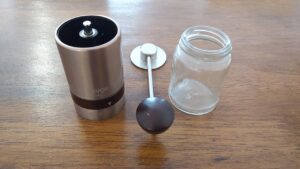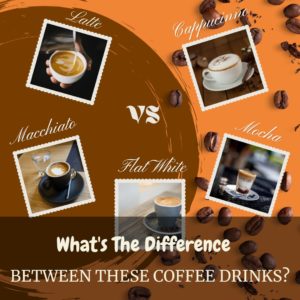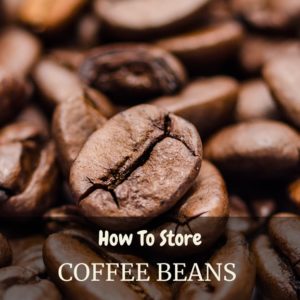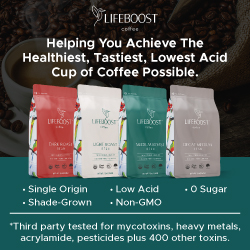Do you often get confused with that ever-growing coffee menu? I know I sometimes do. That’s why I spent some serious time and put together a list of all coffee specialties from around the world so that you don’t get confused when looking at coffee menus. And while I didn’t have the opportunity to taste every single one of them, I did prepare and brew a fair share. It will help you to make an informed decision before choosing and ordering different coffee drinks.

But first, let’s get one thing clear. Some of these different coffee drinks look and taste very similar. That’s why explaining the differences is often challenging. Also, if you visit cafes in your country or around the world, you might find the same drink under different names. Or the other way around – different drinks may be served under the same name.
You’ll have more clarification after getting familiar with various coffee beverages. But keep in mind that these definitions are not set in stone.
For easier navigation through this long list, I’ve put in the table of contents:
Now let’s get down to business and see what different coffee drinks are out there.
Black Coffee
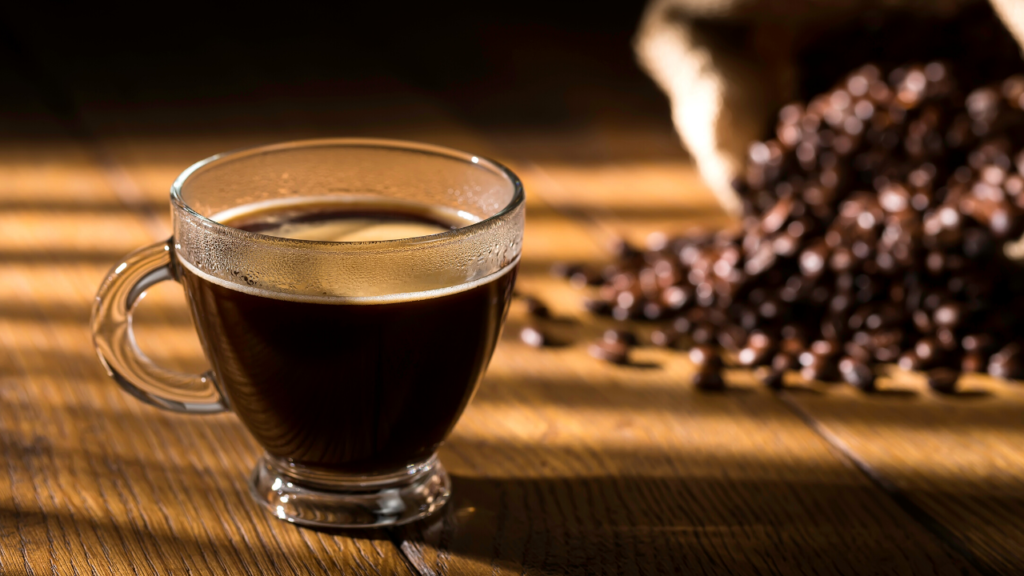
#1 – Drip Coffee
In the US, drip coffee is a synonym for brewed coffee. It’s called drip of filter coffee because the coffee maker heats up the water and lets it drip over a filter with coffee grounds. The coffee is not so strong and concentrated as compared to espresso. The traditional brewing process with old-school filter coffee makers is rather slow. In recent years modern batch brew coffee machines have emerged. They make brewing large quantities of coffee easy and efficient.
#2 – Pour Over
In essence, a very simple manual method. You pour hot water into a filter with coffee grounds. The water with extracted coffee drains through a filter into a carafe. You can make it with devices such as Hario V60, Kalita Wave, Chemex, etc. It’s a popular method for accentuating flavors of single-origin coffees.
#3 – AeroPress
Popular coffee brewing method among enthusiasts worldwide. You’ll need AeroPress – a manual coffee maker invented by Alan Adler. Put medium-fine coffee grounds into a chamber, mix it with hot water and let it steep for a minute. Then gently push the plunger and the air pressure (hence the name) extracts rich and smooth coffee directly into a mug.
#4 – French Press
Another immersion coffee brewing method. Immerse the coarse coffee grounds into hot water inside the French press. Let it steep for a few minutes. Then press it into a cup or carafe. The metal filter allows coffee’s natural oils as well as some micro grounds into the cup. The coffee has a full and rounded flavor.
#5 – SoftBrew Coffee
SoftBrew is another simple way of making coffee with Sowden brewer. Put coarse coffee grounds inside the metal filter within the brewer. Add the hot water and stir so that the grounds are all saturated. After 4 minutes of steeping, pull out the filter and the coffee is ready.
#6 – Vacuum Coffee
The concept dates from the 19th century. You need a siphon coffee maker that has two chambers to make vacuum coffee. Heat the water in the lower chamber and put the coffee in the upper chamber. The pressure forces water to go up to where it combines with coffee grounds. When you remove the heat, the water, infused with the coffee, goes back into the lower chamber. Vacuum coffee has returned to the scene in recent years and more and more cafes are serving it.
#7 – Instant Coffee
This drink is so convenient that anyone can make it. Mix a teaspoon of instant coffee with some hot water into a mug and consume it immediately. Though the taste is not as good as a freshly brewed coffee, it’s very popular in some regions and parts of the world.
#8 – Coffee Bags
The preparation is very simple as if you are making tea. Toss the coffee bag into a mug or a cup, pour in some hot water and let it steep for a few minutes. Find and order the bags at small roasters of specialty coffee shops. You can even make your own coffee bags.
#9 – Cowboy Coffee
You may not find it in your regular coffee shop. Heat the water in a kettle on the stovetop, or over an open flame if you’re in the woods. When the water is boiling, toss the coffee grounds into the kettle (coffee to water ratio is 1:4). Remove the kettle from the heat and let it sit for a couple of minutes. Strain the grounds with a coffee sock or sieve (or add some cold water).
#10 – Turkish Coffee
One of the most popular coffee drinks in the Middle East and Balkans. This method uses extra-fine, powder-like, grounds without any filtration. Thus, the grounds fall to the bottom of the cup before you drink it. It’s strong and rich, like a thick espresso. It’s served with a glass of water so that you can clean the palate before you indulge yourself with a black delight.
Espresso based drinks
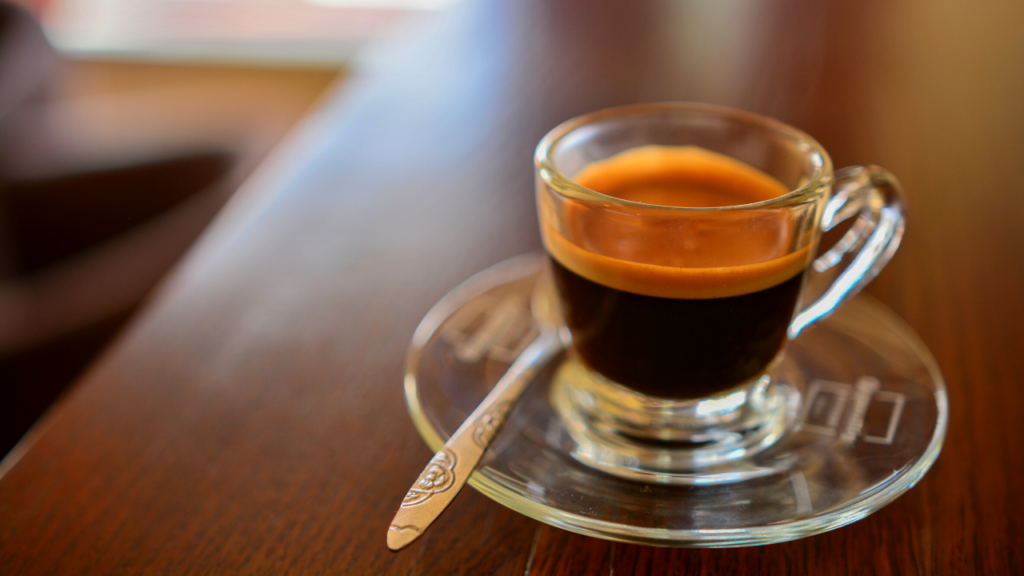
#11 – Single Espresso
Espresso is a product of forcing a small amount of nearly boiling water under pressure through finely-ground coffee beans. It’s a very intense, short, concentrated beverage with a rich taste, smooth structure and crema at the top. It has more coffee per unit volume and it’s generally thicker than most coffee beverages. Dark or medium to dark roasts are best for espresso. It’s the starting point for many popular coffee beverages.
#12 – Double Espresso
Also known as Doppio or Zorro. It’s double the size of regular espresso, but with the same intensity. The extraction goes through a double-spout portafilter. The cup is bigger, usually the one for a cappuccino. Typically, you can get away with a better price than two espressos. If you drink single espresso, pay attention that some cafes serve only double.
#13 – Ristretto
Ristretto means shortened or narrow in Italian. It’s a shot of espresso coffee that consumes the same amount of coffee but yields a shorter drink due to half amount of water. The brew time is shorter and the grind is finer than espresso which leads to a punch of acidity and sweetness. It’s stronger than espresso with a heavier body. Coffee to crema ratio is almost 1:1.
#14 – Lungo
Lungo stands for long in Italian. Generally, twice as much water than in espresso used. That results in a larger shot usually served in a bigger cup. The amount of grounds is the same as in espresso but you get less intense coffee due to prolonged extraction. The acidity is lower and the body is lighter. Unlike regular espresso, you sip it instead of drinking it in one shot.
#15 – Café Cubano
Café Cubano originates, well, from Cuba. Though it might look the same as a regular espresso, you prepare it in a slightly different way. First, you whip a couple of drops of espresso with sugar into a thick, foamy crema-like texture. Then, you top a regular espresso shot with whipped sugar. It’s very sweet so you might not want extra sugar.
#16 – Espresso Romano
Despite its name, this citrusy coffee was apparently invented in the United States. You prepare it by pulling a shot of espresso and adding one or more lemon slices – squeeze them or drop into coffee to infuse some citrusy flavors. The coffee is super refreshing and you can serve it in lots of variations – hot, cold, iced, with or without milk, with or without sugar.
#17 – Americano
It’s also known as Espresso Americano or Caffè Americano. You prepare it by diluting an espresso with hot water. It has a similar strength but a different flavor from filter coffee. The people who order this drink prefer less intense coffee but still want the flavor characteristics of espresso. In Italy, Caffè Americano could mean either espresso with hot water or filtered coffee. Another variant is Long Black.
#18 – Long Black
This drink is common in Australia and New Zealand. It’s like Americano but with a stronger aroma and taste. Both drinks keep the crema when brewed properly. Though, in the Long Black, the crema is more pronounced. You make it by pouring a double shot of espresso or ristretto over a smaller amount of hot water. Usually, you use ½ cup of hot water, but it may vary to individual taste. The less water means the stronger taste.
Espresso with coffee
#19 – Red Eye
Red Eye is a very intense coffee drink. You put 350 ml (12 oz) of drip coffee into a mug and top it with an espresso shot. Add any sort of milk, to sweeten the taste. It’s a quick wake-up in the morning.
#20 – Black Eye
Same as Red Eye with a double amount of espresso – dripped coffee with a double shot of espresso.
#21 – Dripped Eye
Same as Red Eye with a triple amount of espresso – dripped coffee with a triple shot of espresso.
#22 – Lazy Eye
Decaffeinated coffee with a single or double shot of espresso.
Milk-based espresso drinks

#23 – Macchiato
It’s also called Espresso Macchiato or Caffé Macchiato in Italy. Macchia in Italian means stain. Thus, macchiato literally means “stained” or “marked” or “spotted”. It’s an espresso coffee drink with a small amount of milk, usually foamed. You won’t find any smaller milk espresso drink than macchiato. It gives a stronger punch than other espresso-based drinks with milk. You serve it in a glass or 60 ml (2 oz) ceramic espresso cup. Ideal for those who drink coffee with milk but want to taste more coffee.
#24 – Cortado
This drink originates from Spain. Its US variation is Gibraltar because it’s served in the “Gibraltar” glass. It’s an espresso drink where the espresso is cut in equal parts with hot milk. The texture is flat – as compared to latte or cappuccino. It has reduced acidity because the espresso is evenly balanced with the same amount of foamed milk. Still, you should get that espresso punch. Cortado is usually served in a 120 ml (4 oz) glass. People often confuse it with piccolo latte.
#25 – Espressino
The origin is Italy. You prepare it with espresso, steamed milk and cocoa powder or Nutella. First, put the cocoa powder at the bottom of the cup. If you wish, spread some Nutella on the walls. Pull an espresso shot into that cup and pour over an equal amount of steamed milk. Sprinkle some cocoa on the top. It’s like a choco version of Cortado.
#26 – Caffe Latte
The name comes from Italian which means coffee and milk. It’s an introductory coffee drink made with 1 shot of espresso with 220-300 ml (8-10 oz) of foamed milk. Ideal for those who want to drink more milk and less coffee. You’ll find it served in a big 300-350 ml (10-12 oz) cup.
#27 – Piccolo Latte
A ristretto shot is usually used as a base for Piccolo Latte, but sometimes it can be a single or a double espresso shot. It depends on where you order it. The base is about 1/3 of the drink and the rest is filled up with steamed milk that gives a lot more sweetness. Milk has a smooth velvety texture, it’s not as frothy as in cappuccino. The foam level (if any) is very thin. It’s not so common in US coffee shops unless it’s a specialty cafe or it has Australian culture. In AU and NZ piccolo latte and cortado might be the same drink.
#28 – Latte Macchiato
Latte Macchiato is the opposite of espresso macchiato. The milk is “stained” with a shot of espresso. You make it by adding milk into the glass and topping it with a shot of espresso. You have to pour the coffee slowly over the milk to preserve the layers. It’s served in a large 350 ml (12 oz) glass.
#29 – Flat White
Another popular espresso drink comes from Australia and New Zealand. It combines a shot of espresso with 120 ml (4 oz) of steamed milk served in a cup for cappuccino or smaller. It’s comparable to a latte but with a smaller volume, less microfoam and more coffee flavor. The milk is more velvety in consistency allowing the espresso to dominate the flavor.
#30 – Cappuccino
Cappuccino is a mixture of coffee, steamed milk and microfoam (from foamed milk). The ratio between these three can vary, but it’s usually ⅓ of each ingredient. Some variations involve using cream instead of milk. The volume is smaller than the caffe latte because it contains less milk and it has a thicker layer of microfoam. When latte drinkers want more coffee flavor in their coffee, they order a cappuccino. It’s served in a 150-200 ml (5-7 oz) cappuccino cup.
#31 – Long Macchiato
This drink is often confused with macchiato or latte macchiato for obvious reasons. It’s made by topping a double shot of espresso with a dollop of steamed milk with microfoam at the top. It‘s the same drink as its shorter cousin macchiato but double in size. The serving glass is 150-200 ml (5-7 oz).
#32 – Cortadito
You make Cortadito by whisking sugar with a few espresso drops until you get a layer of foam, like with Café Cubano. Then you pour hot milk into the cup with espresso shot using a 1:1 ratio and top it with the foam. It is often confused with Cortado.
#33 – Breve
Yet another form of espresso with milk. The milk in this case is half-and-half which is a lot heavier than whole milk or skim milk. Because of rich and heavy crema, it tends to coat the mouth a bit more and the aftertaste is longer. It almost feels like drinking ice cream. In some coffee shops, you can order breve variants of latte, cappuccino and even a cortado.
#34 – Mocha
Also known as Cafe Mocha. It’s a variant of caffe latte with the addition of chocolate to the espresso as a base. You can use any type of chocolate. First, put some chocolate into the cup and pour an espresso shot over to warm it up. The chocolate thickens the espresso. Top it with steamed milk and decorate with some grated chocolate, whipped cream, chocolate syrup, etc. The taste is sweet and delicious.
#35 – Café Borgia
Café Borgia is a mocha variant that involves espresso, hot chocolate and whipped cream topping. Instead of chocolate dust or sprinkles, grated orange peel is used for decoration. It gives nice citrusy notes. The orange combines well with the chocolate and gives it a new fresh experience.
#36 – Vienna Coffee
Vienna coffee is the name of a popular traditional cream-based coffee beverage. If you are in Vienna and want to order this drink you should ask for Einspänner. You make it by preparing two shots of espresso in a coffee cup and infusing it with about 60 ml (2 oz) of the whipped cream until the cup is full. Top it with chocolate sprinkles, cocoa powder or cinnamon. Thanks to the whipped cream, you might not need any additional sweetening. It’s a creamy and decadent drink meant to indulge while you slowly sip the coffee through the fluffy layer of whipped cream. Serve it in a wide cup or in a tall transparent glass that exposes 2 distinctive layers.
#37 – Espresso Con Panna
Means “Espresso with cream” in Italian. It’s almost like Vienna Coffee. Take a regular espresso shot and top it with a dollop of whipped cream to enhance flavors and texture. The better option is to whip the cream by hand or mixer instead of using the one from the can. It is heavier and makes a thick layer on the top of the espresso..
#38 – Café au Lait
Depending on where you order it, the name varies from Coffee with milk to “Café au lait” (French) to “Café con leche” (Spanish) to “Milchkaffee” (German). The coffee is usually French press or pour over but can also be an espresso shot or filter coffee. Add the coffee to the cup and pour over an equal amount of steamed milk. You can top it with a milk foam but it’s not mandatory (like it is with a latte).
Cold coffees and coffee desserts
#39 – Iced Espresso
You make this drink by pulling an espresso shot straight into the cup with ice cubes. A slightly different (cooler) variant is that you let espresso cool down and then pour it into the cup. It’s one of the simplest iced coffee drinks you can order.
#40 – Espresso Freddo
The idea of Espresso Freddo was born in Greece. You make it by combining a single or double shot of espresso with the ice cubes in a shaker. The result is a nice chilled espresso with foam that you pour over the ice cubes in a tall glass. The foam created from shaking with ice makes everything neatly connected. It’s for the people who like espresso, but in the hot period, they prefer something cold having the same flavor.
#41 – Iced Cappuccino
The secret of Iced Cappuccino is with the milk. The fatter milk you use, the better the flavor you get. The preparation is like a regular (hot) cappuccino. Pull a single or a double espresso shot and pour it over into a glass with ice cubes. Top it with steamed milk and microfoam.
#42 – Iced Flat White
You make this drink by combining a double espresso with ice in a shaker. Then pour the foamy espresso over into a glass filled with fat milk. You should be able to distinguish between the layers in the glass. They have a cool look with brown color at the top and white color at the bottom. You mix up the layers in the mouth while you drink it.
#43 – Frappe
Frappe is a traditional Greek iced coffee drink with a lot of adaptations. You make it by combining a shot of espresso and some ice cubes in a shaker or blender. Then add 90 ml (3 oz) of full fat milk and 1 tbsp of simple syrup. Blend everything together and pour over the ice cubes in a tall glass. It’s a super funky and refreshing drink with a lot of foam. An absolute must for summer hanging around pools and beaches.
#44 – Cold Brew
Cold Brew is a great summer coffee drink. The preparation is really simple but the brewing takes several hours. So, you usually make it one day in advance. It has a smoother and stronger taste than regular drip coffee. At the same time, it contains less caffeine. You grind the beans coarsely, combine them with the water and leave it for at least 12 hours. This way the grounds will infuse into the water which makes a strong and concentrated brew. The last step is to strain the concentrate and to serve it in a glass with ice cubes.
#45 – Nitro Coffee
Nitro Coffee is a cold brew infused with nitrogen that conserves the coffee so it can stay fresh for a week. The nitrogen gives more body to it and a rich and creamy head as if you’re drinking Guinness draft beer. The flavor is sweet and there’s a nice velvety cream with a cascading effect. One more thing that feels beery is pouring on the tap.
#46 – Flash Brew
Also known as Japanese Iced Coffee. The process is almost the same as with cold brew with some differences. It takes only a few minutes to make the flash brew so you can enjoy it immediately. You can use a regular pour over or some other coffee and cool it down with ice during or after the extraction. The ice dilutes and cools the coffee solution. It’s an excellent drink for hot days..
#47 – Mazagran
Mazagran originates from Algeria but these days it’s popular in Portugal. Pull a shot of espresso, or other strong coffee, into the cup. Sweeten it with sugar or honey and pour over ice cubes in a glass. Finish the drink by squeezing a lemon. Stir and serve. You can make it sour or sweet, depending on your preferences.
#48 – Affogato
This drink comes from Italy where it literally means “drowned”. It’s a combination of ice cream and espresso. First, you scoop some vanilla ice cream into a 100 ml (3.4 oz) glass. Then, you pull a shot of espresso and pour it over into the glass, and voila, your treat is ready! It’s a real refreshment to enjoy over the summer and you can eat it with a spoon, like a real coffee dessert.
#49 – Freakshake
It’s really hard to define what a Freakshake is: a mishmash of coffee, syrups, milk, sweets and so on…there are no limits! You blend the ingredients of choice, put them in a glass and infuse whipped cream. It’s super sweet and you can top it with salty and/or sweet titbits, from pretzels to fruit to cookies.
#50 – Dalgona Coffee
As with a lot of stuff that comes from South Korea, Dalgona Coffee made it an instant hit via TikTok and Instagram. The name in Korean means coffee candy, but it’s also known as “whipped coffee”, “frothy coffee”, or “fluffy coffee”. It’s pretty simple to make it. Combine instant coffee with sugar in 1:1 ratio, add hot water and whisk until it’s creamy and fluffy. Scoop the mixture into a glass over the iced milk, decorate and drink.
Coffee cocktails
#51 – Irish Coffee

This drink originates in Ireland but it’s spread all around the world as a cocktail classic. It’s a mix of coffee, Irish whiskey and sugar (or sweet syrup) with whipped heavy cream at the top. It makes a perfect after-dinner drink, especially in chilly evenings.
#52 – Espresso Tonic
This simple cocktail got quite popular recently. You make it by pouring 60-90 ml (2-3 oz) of tonic water over ice cubes in a glass. Then top it with an espresso shot. The result is a refreshing summer cold coffee drink. The keyword is the balance between the bitterness & sparkliness of the tonic water and the acidity & sweetness of the espresso.
Exotic and unusual coffees
#53 – Bulletproof Coffee
This drink is a mix of coffee and healthy fats, also known as boosted coffee or butter coffee. Despite the name, you don’t need to use branded Bulletproof Coffee beans to make one. Instead, you make coffee the usual way (pour-over, AeroPress, etc.). Pour it into a blender, add fats and some sweetener (if you prefer). Blend it until you get a creamy beverage. You can use various healthy fats one by one or mixed. These include grass-fed butter, MCT / Brain Octane oil, coconut oil, coconut butter, etc.
#54 – Cha Phe Sua Da (Vietnamese)
Experience some authentic taste of Vietnam through this very strong and sweet drink. Dark roasted beans are a must. This method brews coffee directly into a glass. Put some condensed milk in the glass and cover it with a phin filter (Vietnamese metal coffee filter). Fill the filter with coffee grounds and hot water. When brewing is finished, stir the coffee with milk and pour it over ice in a tall glass.
#55 – Green Coffee
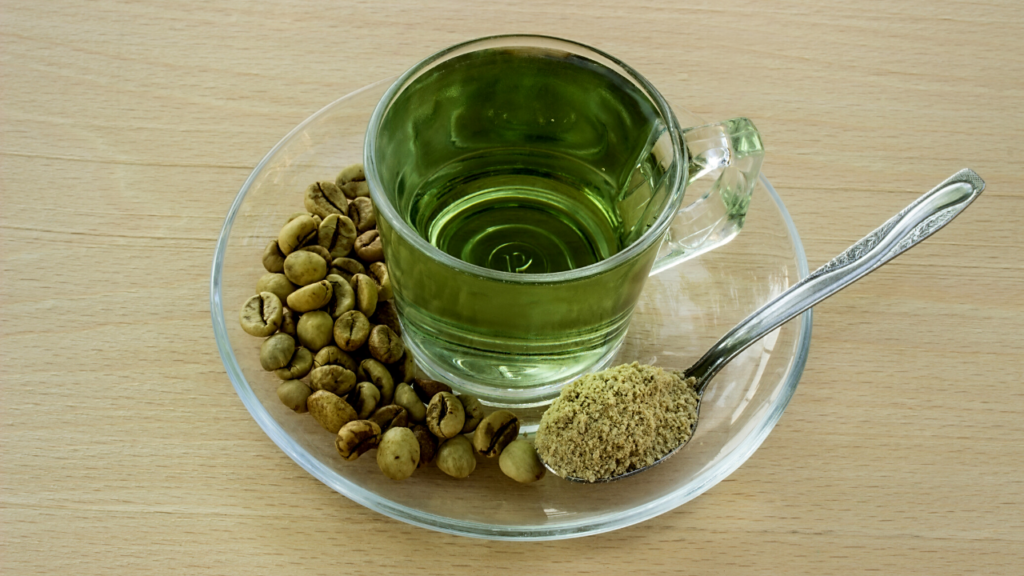
This coffee drink is like tea. The coffee beans are not processed nor roasted so they keep their original green color. It’s a healthier option than your regular cup of coffee because of the lower amount of caffeine. You can use whole beans or grounds. If you use whole beans, leave it in water through the night, boil on the next day, filter and drink when cooled down. If you use ground beans, then pour hot water over, let it rest for 10 minutes, filter and drink.
What next?
Now that you’re familiar with the majority of the different coffee drinks, go on and order something different in your cafe. It may become your new favorite.

